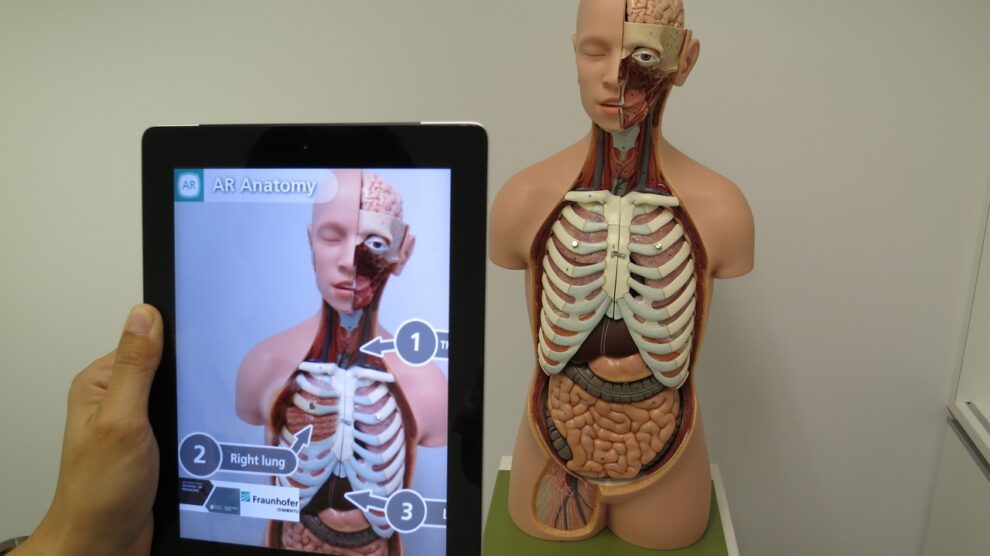Gone are the days of limited options and one-size-fits-all approaches. Today, advancements in technology are revolutionizing the healthcare industry, making it more patient-centric than ever before. One such breakthrough is Augmented Reality (AR), a technology that is seamlessly integrating into healthcare practices to elevate patient experience.
Let’s understand what Augmented Reality is, explore the transformation of healthcare over time, and uncover the pivotal role AR plays in improving patient care. Also, let’s discuss the pros and cons of integrating AR into healthcare to give you a well-rounded understanding of its impact.
What is Augmented Reality?
Augmented Reality, or AR, is a technology that overlays digital information, such as images, videos, or 3D models, onto the real world. Unlike Virtual Reality (VR), which immerses you entirely into a computer-generated environment, AR enhances your perception of the real world by adding digital elements to it. This is typically achieved through the use of devices like smartphones, tablets, or specialized AR headsets.
How Healthcare Has Improved Over the Years?
The healthcare landscape has evolved significantly over the years. In the past, healthcare was often a reactive process, primarily focused on treating illnesses after they occurred. Medical interventions were typically invasive, and patients had limited access to information about their conditions.
However, the advent of technology and medical advancements has led to a paradigm shift.
- Preventive Care: With the help of augmented reality, healthcare providers can now emphasize preventive care. AR can be used to create interactive educational materials that teach patients about healthy lifestyles and early warning signs of various medical conditions. This empowers patients to take proactive steps to maintain their health.
- Telemedicine: Telemedicine, which has gained immense popularity, allows patients to consult with healthcare professionals remotely. AR can enhance telemedicine by providing doctors with real-time data and visual aids during virtual consultations, ensuring accurate diagnoses and treatment plans.
- Personalized Medicine: The era of one-size-fits-all treatment is fading away. Augmented reality aids in tailoring treatment plans to individual patients. By overlaying patient data and diagnostic information onto the physical examination, doctors can make more precise decisions, leading to better outcomes.
Role of Augmented Reality in Healthcare
Augmented Reality is making waves in the healthcare sector, contributing to a more patient-centered and efficient approach to care. Let’s explore the key ways in which AR is transforming the patient experience.
- Medical Training and Education: AR offers a lifelike platform for medical professionals to train and educate themselves. Surgeons, for instance, can practice complex procedures on virtual models, improving their skills and reducing the risk associated with live surgeries.
- Enhanced Visualization: One of the most significant advantages of AR in healthcare is its ability to provide visual aids. Surgeons can use AR to overlay medical imaging data, like MRI or CT scans, onto a patient’s body during surgery. This real-time visualization assists in precise navigation, reducing the likelihood of errors.
- Remote Assistance: AR enables specialists to provide real-time guidance to on-site healthcare workers in remote or underserved areas. This ensures that patients in these regions receive expert care without the need for extensive travel.
- Rehabilitation: AR-based apps and games are being used to make physical therapy and rehabilitation exercises more engaging for patients. These interactive experiences motivate patients to adhere to their treatment plans, leading to faster recovery.
Pros and Cons of AR in Healthcare
As with any technological innovation, Augmented Reality in healthcare brings both advantages and challenges. Let’s explore some of the key pros and cons.
Pros:
- Enhanced Patient Engagement: AR apps and experiences make healthcare more engaging for patients, increasing their involvement in their own care.
- Improved Diagnostics: Augmented reality aids in more accurate and timely diagnoses by providing healthcare professionals with better visualization tools.
- Efficient Training: Medical professionals can train more effectively, leading to a higher level of expertise and better patient outcomes.
- Accessible Care: AR facilitates telemedicine and remote consultations, making healthcare more accessible, especially in remote areas.
Cons:
- Cost: Implementing AR technology can be expensive, and not all healthcare facilities may have the resources.
- Data Security: The use of AR in healthcare raises concerns about the security and privacy of patient data.
- Learning Curve: Healthcare professionals and patients may need time to adapt to AR technology, potentially slowing down its adoption.
- Technical Issues: AR can experience technical glitches like any technology, which could disrupt patient care.
To Wrap Up
Augmented Reality is ushering in a new era of patient-centered healthcare, where prevention, personalization, and precision are paramount. This transformative technology empowers patients and healthcare professionals, enhancing engagement, improving diagnostics, and expanding access to care.
However, it is essential to acknowledge the challenges that come with the integration of AR into healthcare, such as cost and data security concerns. As AR continues to evolve, its role in healthcare will become even more significant, ultimately leading to better patient experiences and improved health outcomes.





